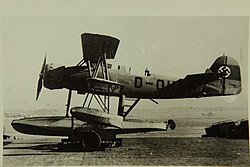Focke-Wulf Fw 62
| Focke-Wulf Fw 62 | |
|---|---|
 Fw 62 V2 or V3 (D-OHGF) |
|
| Type: | twin-engine trainer aircraft |
| Design country: | |
| Manufacturer: | |
| First flight: |
October 23, 1937 |
| Number of pieces: |
2 or 4 |
The Focke-Wulf Fw 62 was a floatplane from the manufacturer Focke-Wulf intended as a catapult capable airborne patrol , of which two or four prototypes flew at the end of the 1930s .
history
The aircraft was designed in 1936 after a tender by the Reich Aviation Ministry (RLM) for a two-seater float plane that was to be launched by warships by catapult. In addition to Focke-Wulf, Arado , Dornier and the Gothaer Waggonfabrik also took part in the tender . Arado and Focke-Wulf each received an order to build prototypes. There are different statements about the number in the literature. Usually four are mentioned, but according to Wagner the order was only for two test aircraft. Erich Arbeitlang carried out the detailed development on behalf of Kurt Tank . He designed a conventionally in composite construction executed zweistieligen, braced biplane . The wings could be folded down, which reduced the span to 4.40 m or 4.60 m for the single-float version.
All four test aircraft were equipped with a BMW 132K engine. The V1 ( registration D-OFWF) had its first flight on October 23, 1937. The following V2 (D-OKDU) had a two-float mechanism just like the V1. With the V3 (D-OHGF) and V4 (D-OMCR), however, a central float with two external support floats was used.
In the comparative flight between the Fw 62 and the Arado Ar 196 carried out in Travemünde from January 1938 to March 1938, the Fw 62 made a good impression. It was even superior to the Arado pattern in flight and sea characteristics. However, the RLM decided on the Ar 196, which on the one hand was faster and, due to its single-deck design, also easier to manufacture.
The Fw 62 were used for some time to further investigate the float suspension. According to Becker, the V1 and V4 temporarily had the new D-ICDS and D-IMGD marks.
construction
The fuselage structure, designed as a welded tubular steel construction, was covered with fabric. Both wings had ailerons and flaps. Typical for Focke-Wulf were the discs on the braced horizontal stabilizer, which were supposed to prevent pressure equalization between the rudder and the stabilizer fin.
A special feature was the spring-loaded suspension of the floats. The experience gained with the Focke-Wulf W 7 could be used here. With a good coordination of the springs, there was actually a certain reduction in the shock load.
Technical specifications
| Parameter | Data |
|---|---|
| crew | 2 |
| length | 11.15 m |
| Span (bottom and top) | 12.35 m |
| height | 4.30 m |
| Wing area | 36.10 m² |
| Wing extension | |
| Preparation mass | 2158 kg |
| Max. Takeoff mass | 2875 kg |
| Top speed | 280 km / h |
| Marching speed | 265 km / h |
| Range (at marching speed) | 900 km |
| Engines | 1 × BMW 132K with 960 PS (705 kW) |
| Armament | 1 × MG 15 in the slewing ring, bomb load up to 100 kg |
literature
- Hans-Jürgen Becker: Seaplanes - flying boats, amphibians, float planes (Die deutsche Luftfahrt Volume 21) , Bernard & Graefe Verlag, 1994, ISBN 3-7637-6106-3 , pp. 63-65.
- Wolfgang Wagner: Kurt Tank - designer and test pilot at Focke-Wulf (Die deutsche Luftfahrt Volume 1) , Bernard & Graefe Verlag, 1980, ISBN 3-7637-5271-4 , p. 42, p. 194 f.
- Heinz J. Nowarra : The German Air Armament 1933-1945 (Volume 2) Bernard & Graefe Verlag, Koblenz 1993, ISBN 3-7637-5464-4 , pp. 63-65.
Web links
- Focke-Wulf Fw 62 on www.luftarchiv.de , with photos